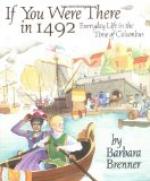Even at this early period of his administration, Fonseca appears to have made some attempts to thwart the admiral’s wishes, attempts which Columbus, now at the zenith of royal favour, had no difficulty in baffling. As regards the household, for instance, Fonseca demurred to the number of footmen which the admiral proposed for his domestic establishment. The admiral appealed to the sovereigns, who allowed his claim, and reproved Fonseca for objecting.
CHAPTER VI. Second Voyage of Discovery.
On the 25th of September, all the preparations being complete, the squadron left Cadiz for the Canary Islands, and, after taking in provisions there, sailed from Ferro on the 13th of October. The voyage was singularly prosperous. There was but one storm, and that of not more than a few hours’ duration; and favouring breezes wafted them over calm seas with a rapidity that brought the ships within sight of land on the 3rd of November, having made the voyage “by the goodness of God, and the wise management of the admiral, in as straight a track as if they had sailed by a well-known and frequented route.” It was Sunday, and accordingly the name of Dominica was given to the first island to which the admiral came.
Island of Guadaloupe.
From Dominica, where no aborigines were found, the admiral stood northward, naming one small island Maria Galante, after his own flagship, and calling a second and much larger one Guadaloupe, after a certain monastery in Estramadura. This island was peopled by a race of cannibals; and, in the houses of the natives, human flesh was found roasting at the fire. An exploring party from one of the ships penetrated into the interior, but so thickly was it wooded that they lost their way in the jungle, and only regained the ships after four days’ wanderings, and when their safety was despaired of by their companions, who feared that they had become food for the savages. Fortunately, however, the men of the island were absent on some warlike expedition, and the white men only met with women and children in the course of their dangerous explorations.
Destruction of la Navidad.
Anxious to revisit the colony at La Navidad, the admiral proceeded north-westward as speedily as possible, and after passing and naming Montserrat, Antigua, St. Martin, and Santa Cruz, arrived at a beautiful and fertile island which he called St. John, but which has since received the name of Porto Rico. Here were found houses and roads constructed after a civilized fashion; but proofs that the inhabitants were cannibals abounded everywhere. On the 22nd of November the admiral reached the eastern end of Hispaniola, and sailed along the northern shore toward La Navidad, where a profound disappointment awaited him. The little colony which he had founded had been entirely destroyed. The fort was razed to the ground. Not one of the settlers was alive to tell the tale.




